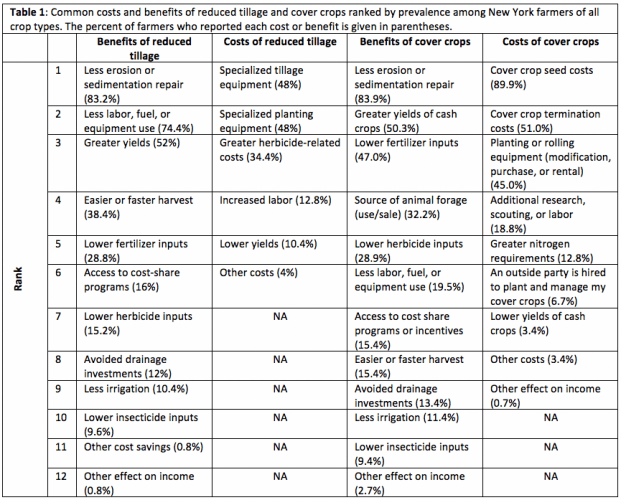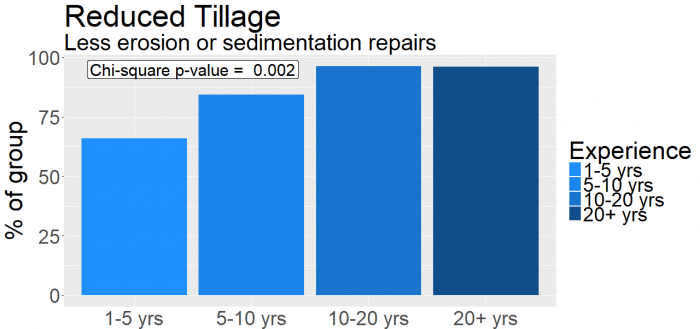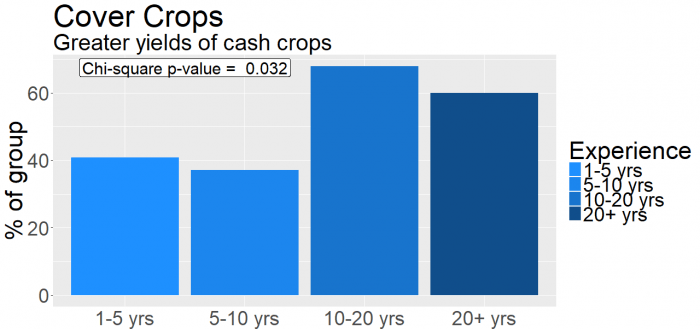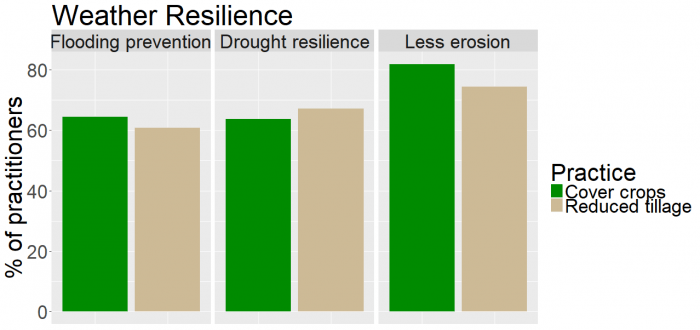By Cedric Mason (cwm77@cornell.edu) and David Wolfe (dww5@cornell.edu)
The condition of a farm’s soil has an important impact on crop production and the environment. Healthy agricultural soil holds adequate nutrients, absorbs heavy rainfall, and stores water. But in many annual production systems these functions are compromised by tillage that diminishes soil organic matter and creates compaction, ultimately restricting crop growth while increasing susceptibility to drought, erosion, and nutrient losses. Healthy soil, containing substantial levels of organic matter and beneficial pore space, can be developed over time by reducing tillage and using cover crops. But both strategies require significant investments of time and resources, while the benefits may require some years to take effect and are difficult to quantify.
To help clarify exactly what costs and benefits farmers in New York experience when using these soil health-enhancing practices, we conducted a state-wide survey during the winter of 2017-18. Over 180 farmers from 46 NY counties provided information about the crops they grow, and how using reduced tillage and cover crops have impacted their farm business. From the survey results, we identified the most frequent expenses and benefits (Table 1).
Note that costs and benefits reported in Table 1 go beyond revenue associated with yield, to include increases or decreases in annual input costs, as well as avoided investment costs (e.g., drainage systems). The most common benefit of both reduced tillage and cover crops was less erosion or sedimentation repair. Greater yield was reported by 52% of farmers using reduced tillage, and by 50% of those using cover crops. Lower yield was reported by 10% and 3% of farmers using reduced tillage and cover crops respectively (Table 1). When asked about profitability, less than 5% reported that either practice had a negative net impact (data not shown).
Our survey also found distinctions in the costs and benefits depending on the type of cash crop being produced, for example greater yield of cash crops attributed to the use of cover crops was more frequently reported for vegetable systems than for corn and soybean, while corn and soybean systems in particular were more likely to benefit from forage uses of cover crops (data not shown). These results emphasize the differences that exist between cropping systems, and show that any decision to implement a specific soil health practice should be made on a case-by-case basis, carefully evaluating both the positive and the negative impacts that could occur following a shift in management practice.
Some benefits that result from these practices are realized over many years as the productivity and function of the soil is gradually improved. We asked farmers how long they had been using reduced tillage and cover crops, and found that there was an association between the length of time a farmer had been using those practices and what benefits they saw. Farmers that had been using reduced tillage and cover crops the longest saw greater benefits. One such benefit is less erosion or sedimentation repair. While about 66% of farmers who had used reduced tillage for less than 5 years reported this benefit, after 10 years that number approached 100% (Fig 1). Similarly, among farmers who used cover crops, greater yield of cash crops was associated with long-term cover crop use (Fig 2).
We also wanted to know if farmers in New York state are improving their resilience to severe weather events by using soil health practices. Rainfall patterns in the region could change in the future, and we hypothesized that enhanced soil health provides protection against flooding and erosion from especially heavy downpours due to the presence of stable aggregates and the soil’s increased capacity to absorb water. That same healthy soil may also help a farmer during times of drought by storing water in the soil profile and making it available for crop growth. Both reduced tillage and cover crops were found to help farmers cope with extreme weather events, with over 60% reporting resilience benefits (Fig. 3).
This study was conducted by New York Soil Health, and funded by NYS Dept. of Ag & Markets and Cornell University College of Agriculture and Life Sciences (CALS).
Download PDFThis article also appears in:



